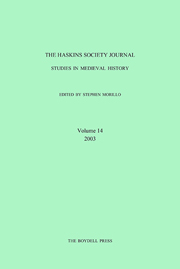Book contents
- Frontmatter
- Contents
- List of Illustrations
- Editorial Note
- Abbreviations
- 1 Even the Devil (Sometimes) has Feelings: Emotional Communities in the Early Middle Ages
- 2 Alcuin, Willibrord, and the Cultivation of Faith
- 3 Henry Loyn Memorial Lecture: English Identity from Bede to the Millennium
- 4 The ‘Farm of One Night’ and the Organisation of Royal Estates in Late Anglo-Saxon Wessex
- 5 Changing Fortunes: Edwardian Anglo-Jewry and their Credit Operations in Late Thirteenth-Century England
- 6 Forty Acres and a Mule: the Mechanics of English Settlement in Northeast Wales after the Edwardian Conquest
- 7 Consanguinity and the Saint-Aubin Genealogies
- 8 Widows, Religious Patronage and Family Identity: Some Cases from Twelfth-Century Yorkshire
- 9 Desecration and Consecration in Norman Capua, 1062–1122: Contesting Sacred Space during the Gregorian Reforms
- 10 From Ego to Imago: Mediation and Agency in Medieval France (1000–1250)
9 - Desecration and Consecration in Norman Capua, 1062–1122: Contesting Sacred Space during the Gregorian Reforms
Published online by Cambridge University Press: 05 September 2014
- Frontmatter
- Contents
- List of Illustrations
- Editorial Note
- Abbreviations
- 1 Even the Devil (Sometimes) has Feelings: Emotional Communities in the Early Middle Ages
- 2 Alcuin, Willibrord, and the Cultivation of Faith
- 3 Henry Loyn Memorial Lecture: English Identity from Bede to the Millennium
- 4 The ‘Farm of One Night’ and the Organisation of Royal Estates in Late Anglo-Saxon Wessex
- 5 Changing Fortunes: Edwardian Anglo-Jewry and their Credit Operations in Late Thirteenth-Century England
- 6 Forty Acres and a Mule: the Mechanics of English Settlement in Northeast Wales after the Edwardian Conquest
- 7 Consanguinity and the Saint-Aubin Genealogies
- 8 Widows, Religious Patronage and Family Identity: Some Cases from Twelfth-Century Yorkshire
- 9 Desecration and Consecration in Norman Capua, 1062–1122: Contesting Sacred Space during the Gregorian Reforms
- 10 From Ego to Imago: Mediation and Agency in Medieval France (1000–1250)
Summary
Sometime toward the end of the summer of 1122, armed clerics from the cathedral of Santa Maria in Capua proceeded from the cathedral houses, across town towards the Porta San Angelo. Immediately inside the gate was the complex of buildings belonging to the monks of San Benedetto, a dependency of Montecassino. These buildings were also proximate to the Norman stronghold within the city. The brothers of San Benedetto were preparing to bury one of their own. The cathedral clerics made their way into the church, seized the body lying in extremis, removed the monastic robe from the corpse, trammeled the garment under foot, and threw it into the piazza. The act of desecration was protested by the monks to Pope Calixtus II who granted the abbot the right to excommunicate the cathedral clerics.
This sacrilege was perhaps the most comic moment in a long struggle between Montecassino and the archbishop of Capua. The rivalry had begun with the renewal of monasticism at Cassino, but had become heated when Abbot Desiderius of Montecassino shifted his support to the Norman insurgents in 1062. A fairly successful truce between monks and clergy had been in effect for the last ten years of the reign of Paschal II but open hostilities began again after 1120 at the ascension of the Capuan Archbishop Otto. In October of that year he sent armed forces to ‘despoil’ the three Cassinese dependencies in the city: San Benedetto Pizzuli (from above), San Angelo Odaliskos, and Santo Rufo.
- Type
- Chapter
- Information
- The Haskins Society Journal 142003. Studies in Medieval History, pp. 137 - 150Publisher: Boydell & BrewerPrint publication year: 2005



